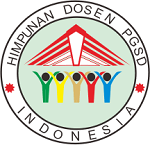UPAYA MENINGKATKAN KEMAMPUAN PASSING BAWAH BOLA VOLI MELALUI MODEL PEMBELAJARAN DIRECT INSTRUCTION PADA SISWA KELAS VI SDN SETONO 5 NGRAMBE
DOI:
https://doi.org/10.24114/jgk.v6i1.28688Keywords:
Direct Instruction, Improves Down Passing, Volleyball Learning.Abstract
Abstract : Efforts to Improve Volleyball Bottom Passing Skills Through the Direct Instruction Learning Model for Class VI Students at SDN Setono 5 Ngrambe. The purpose of this study was to see the results of improving the learning of volleyball underpassing techniques for sixth grade students of Setono 5 Ngrambe State Elementary School, Ngrambe District, Ngawi Regency through the Direct Instruction learning model approach. This research was conducted at SDN Setono 5 Ngrambe class VI consisting of 16 students. The type of this research is using Classroom Action Research (CAR) by using cycles of 2 (two) times where each cycle has two meetings. For data collection techniques than in this study, namely using observations (observations) and trials (tests). Based on observations and tests in the initial implementation, obtained 68.75% of students have not completed the implementation of learning or as many as 11 students. These results become a reference for researchers to implement improvements in the first cycle in order to improve student learning outcomes and complete student grades. The results of the first cycle obtained 9 students who are complete in carrying out learning or 56.25% of students who have completed. In the second cycle there was a very good increase as many as 14 students completed in carrying out volleyball lessons with the passing technique below or as many as 87.5% were completed. These results prove that the Direct Instruction learning model can improve or improve student learning outcomes in volleyball learning with the down passing technique as expected by the researchers.Keyword : Direct Instruction, Improves Down Passing, Volleyball Learning. Abstrak : Upaya Meningkatkan Kemampuan Passing Bawah Bola Voli Melalui Model Pembelajaran Direct Instruction pada Siswa Kelas VI SDN Setono 5 Ngrambe. Tujuan dari penelitian ini yaitu untuk melihat hasil dari peningkatan belajar teknik passing bawah bola voli terhadap siswa kelas VI Sekolah Dasar Negeri Setono 5 Ngrambe Kecamatan Ngrambe Kabupaten Ngawi melalui pendekatan model pembelajaran Direct Instruction. Penelitian ini dilaksanakan di SDN Setono 5 Ngrambe kelas VI yang tersiri dari 16 siswa. Jenis daripada penelitian ini yaitu menggunakan Penelitian Tindakan Kelas (PTK) dengan menggunakan siklus sebanyak 2 (dua) kali dimana setiap siklus masing-masing dua kali pertemuan. Untuk tehknik pengumpulan data dari pada penelitian ini yaitu mengunggkan pengamatan (observasi) dan uji coba (tes). Berdasarkan observasi dan tes pada pelaksanaan awal, diperoleh 68,75% siswa belum tuntas dalam pelaksanaan pembelajaran atau sebanyak 11 siswa. Hasil tersebut menjadi acuan peneliti untuk dilaksanakannya perbaikan di siklus I guna meningkatkan hasil belajar siswa dan ketuntasan nilai siswa. Hasil dari Pada siklus I diperoleh 9 siswa yang tuntas dalam melaksankan pembelajaran atau 56,25% siswa yang sudah tuntas. Pada siklus II terjadi peningkatan yang sangat baik sebanyak 14 siswa tuntas dalam melaksanakan pembelajaran bola voli teknik passing bawah atau sebanyak 87,5% yang tuntas. Hasil ini terbukti bahwa model pembelajaran Direct Instruction dapat memperbaiki atau meningkatkan hasil belajar siswa pada pembelajaran bola voli teknik passing bawah sesuai yang diharapkan oleh peneliti.Kata Kunci : Direct Instruction, Meningkatkan Passing Bawah, Pembelajaran Bola Voli.References
Asri, and Ikhwan Abdul. 2016. œPeningkatan Pembelajaran Passing Bawah Dalam Permainan Bola Voli Melalui Model Pembelajaran Langsung (Direct Instructions) Pada Siswa Kelas V Sdn No 1 Pesaku Kecamatan Dolo Barat Kabupaten Sigi. E- Journal Physical Education, Healt And Recreation 4(1):1“15.
Chan, Faizal, and Yuli Indrayeni. 2018. œMeningkatkan Kemampuan Passing Bawah Dalam Permainan Bola Voli Melalui Pendekatan Tgfu Pada Siswi Kelas Viii Smp Negeri 11 Muaro Jambi. Journal Physical Education, Health and Recreation 2(2):186. doi: 10.24114/pjkr.v2i2.9590.
Effendy, Fauzan, Yudhi Kharisma, and Riki Ramadhan. 2020. œPenggunaan Modifikasi Permainan Bolavoli Untuk Meningkatkan Kemampuan Passing Bawah. Jurnal Pendidikan Olahraga 9(1):1. doi: 10.31571/jpo.v9i1.1333.
Lubis, Ade Evriansyah, and Muhammad Agus. 2017. œPeningkatan Hasil Belajar Passing Atas Pada Permainan Bola Voli Melalui Variasi Pembelajaran Siswa SMP. Jurnal Pendidikan Jasmani Indonesia 13(2):58“64. doi: 10.21831/jpji.v13i2.21028.
Rithaudin, Ahmad, and Bernadicta Sri Hartati. 2016. œUpaya Meningkatkan Pembelajaran Passing Bawah Permainan Bola Voli Dengan Permainan Bola Pantul Pada Siswa Kelas IV SD Negeri Glagahombo I Tempel Sleman Yogyakarta. Jurnal Pendidikan Jasmani Indonesia 12(1):51“57.
Sahabuddin Sahabuddin, Hikmad Hakim, dan Syahruddin. 2020. œJurnal Penjaskesrek. Jurnal Penjaskesrek 7(2):204“17. doi: https://doi.org/10.46244/penjaskesrek.v7i2.1050.
Saputra, Deka Ismi Mori, and Gusniar Gusniar. 2019. œMeningkatkan Hasil Belajar Passing Bawah Bola Voli Melalui Bermain Melempar Bola. Gelanggang Olahraga: Jurnal Pendidikan Jasmani Dan Olahraga (JPJO) 3(1):64“73. doi: 10.31539/jpjo.v3i1.862.
Sidik, Moch Ilham, and Hendri Winata.
Downloads
Published
How to Cite
Issue
Section
License
Authors published with the JGK (Jurnal Guru Kita) agree to the following terms:
- Authors retain copyright and grant the journal the right of first publication with the work simultaneously licensed under a Creative Commons Attribution License (CC BY-SA 4.0) that allows others to share the work with an acknowledgment of the work's authorship and initial publication in this journal.
- Authors are able to enter into separate, additional contractual arrangements for the non-exclusive distribution of the journal's published version of the work (e.g., post it to an institutional repository or publish it in a book), with an acknowledgment of its initial publication in this journal.
- Authors are permitted and encouraged to post their work online (e.g., in institutional repositories or on their website) prior to and during the submission process, as it can lead to productive exchanges, as well as earlier and greater citation of published work. (See The Effect of Open Access)













